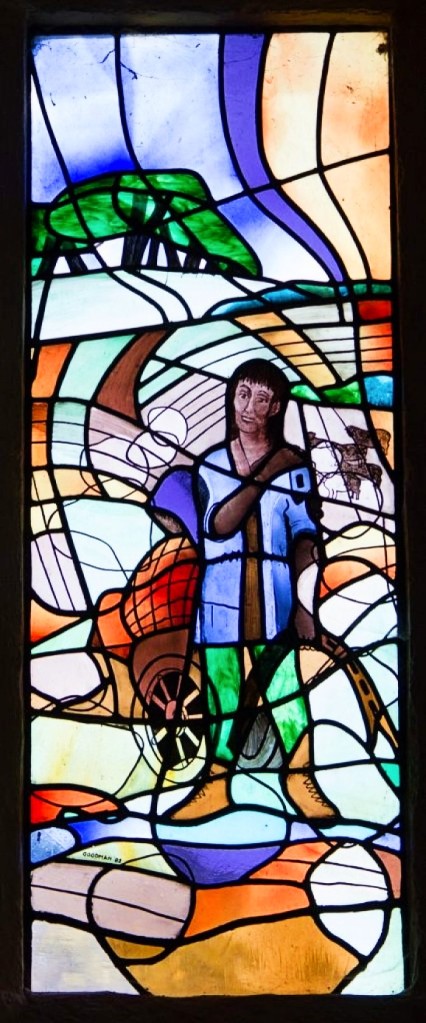Saint of the Day – 8 February – Saint Cuthman of Steyning (Died 8th Century) Hermit, builder of Churches, Miracle-worker. Born in c681 at Chidham, near Bosham, Sussex (some legends say Devon or Cornwall) in England and diedin the 8th Century at Steyning, Sussex, England. Patronages – against poverty, bachelors, poor people, shepherds, of Steyning, England. Also known as – Cuthmann, Cutmano, Cutmanus.

The earliest surviving written record of Cuthman’s life is a volume of the Acta Sanctorum, published by the Bollandists at Antwerp in 1658. According to the story, Cuthman was a shepherd who grew up either in the West Country or at Chidham, near Chichester. He was probably born in the late seventh century and may have been Baptised by St Wilfrid himself, the ‘Apostle of Sussex.’
Even as a young boy, Cuthman showed signs of his closeness to God. One day, while tending his sheep, he drew a line around them with his staff so that he could get away to collect food. On his return, he found that the flock had not left the invisible boundary. This miracle may have taken place in a field near Chidham, which, for centuries was known as ‘St Cuthman’s Field’ or ‘St Cuthman’s Dell.’ It was said that a large stone in the field, ‘on which the holy shepherd was in the habit of sitting,’ held miraculous properties.
A turning point in Cuthman’s life was the death of his father, which left both him and his mother destitute. They decided to leave their home and journey eastwards – in the direction of the rising sun. By this time, Cuthman’s mother was an invalid and so he had to push her in a wheeled wooden cart. A rope that stretched from the handles to the Saint’s shoulders helped carry the burden. When the rope snapped, he made a new one out of withies (willow tree branches used for basketry). The local haymakers laughed at Cuthman’s rather pathetic efforts but Providence soon responded to their merriment by sending a sudden rainstorm, destroying their harvest. Later versions of the story say that, from that moment onwards, it always rained in that field during the haymaking season!
Cuthman decided that once this replacement rope made of withies broke, it would be a sign from God to settle at that place and build a Church. This happened at Steyning, which, according to the Acta Sanctorum, was ‘a place lying at the base of a lofty hill, then woody, overgrown with brambles and bushes but now rendered by agriculture fertile and fruitful, enclosed between two streams springing from the hill above. The Bollandist Monks have also provided us with Cuthman’s prayer as he reached this blessed spot:
“Father Almighty, Thou hast brought my wanderings to an end; now enable me to begin this work. For who am I, Lord, that I should build a house to Thy Name? If I rely on myself, it will be of no avail but it is Thou Who will assist me. Thou hast given me the desire to be a builder; make up for my lack of skill and bring the work of building this holy house to its completion.”
And so, this unlikely builder began constructing a worthy Sanctuary in honour of the One who had guided him safely along his journey ad orientem. Many of the local inhabitants helped him in this great task and on one occasion, according to the legend, he even received Divine assistance. The builders were having trouble with a roof-beam, when a stranger appeared and provided them with a solution. When asked his name, the newcomer replied: ‘I am He in Whose name you are building the Church.‘
He built a wooden Chapel in Steyning, probably on the site of the present Church of St Andrew’s. This building was certainly well established by 857, when King Ethelwulf (father of St Alfred the Great) was buried there.
It seems that pilgrims visited the Tomb of St Cuthman and that his intercession led to many miraculous cures. During the reign of St Edward the Confessor, the Church at Steyning was given to the Abbey of the Holy Trinity at Fécamp, Normandy. This Benedictine house, founded in the seventh century, is famous for its ‘Benedictine’ liqueur, which today is commercially produced in the grounds of the old Abbey. It was to this Monastery that the Black Monks took the body of St Cuthman and his Feast (8 February) was celebrated at many of the religious houses of Normandy. Thus, St Cuthman became well known on the continent – as can be seen in a mid fifteenth century German engraving of the saint by Martin Schongauer and in the writings of the seventeenth century Bollandists.
Meanwhile, the Church at Steyning was rebuilt and dedicated to St Andrew. However, St Cuthman was not forgotten in his beloved land. A ‘Guild of St Cuthman’ was in existence at Chidham on the eve of the Reformation and a misericord in Ripon Cathedral depicts him pushing his mother in a three-wheeled barrow. There are quite a few Churches dedicated to St Cuthman in England but in Steyning, he is particularly loved and venerated.
The colourful tale of St Cuthman presents us with a charming example of filial piety, prayer, evangelisation and Church building in Saxon England. In the words of Christopher Fry:
It is there in the story of Cuthman, the working together
Of man and God like root and sky; the son
Of a Cornish shepherd, Cuthman, the boy with a cart,
The boy we saw trudging the sheep-tracks with his mother
Mile upon mile over five counties; one
Fixed purpose biting his heels and lifting his heart.
We saw him; we saw him with a grass in his mouth, chewing
And travelling. We saw him building, at last,
A Church among whortleberries…







One thought on “Saint of the Day – 8 February – Saint Cuthman of Steyning (Died 8th Century)”